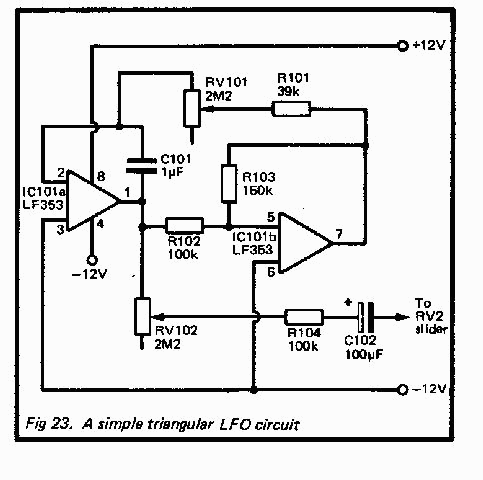<<- Back ^- Intro -^ Forward ->>
Chapter 2: Noise Generator
The LFO
LFO
The use of an LFO (low frequency oscillator) for frequency modulating a VCO to give the vibrato effect was mentioned in Chapter 1. LF0s can actually be used in 'other ways, such as providing one of the voltage sources for a VCF in order to give dynamic effects. It is well worthwhile having one or two LF0s in the system and experimenting with these. Figure 23 shows the circuit diagram for a simple LFO.
This is a circuit of the type which uses a Miller Integrator (IC101a) driving a Schmitt Trigger. (IC101b). RV101 is the frequency 'control, and it gives an adjustment range of very approximately 0.2Hz to 10Hz. The suggested way of using the LFO is to couple the triangular output from 1C101a to the frequency control in the VCO. This is better than trying to couple the signal into the keyboard circuit, where there would be problems with stronger modulation at high notes than when low notes were being played. RV102 is the vibrato depth control. This is only a suggestion for using the unit, and it would probably be worthwhile trying out other ways of using it. The triangular output is the one which is most suitable for the majority of modulation purposes, but do not overlook the fact that a squarewave output signal is available from 1C101b.
LFO Components (Fig 23)
Resistors (all 1/4 watt 5%) R101 39k R102,104 100k R103 150k Potentiometers RVI01,102 2M2 Lin Capacitors C101 1uF miniature polyester C102 100uF 25V radial electrolytic Semiconductors IC1 LF353 Miscellaneous Circuit board Two control knobs 8,pin DIL IC holder, wire, etc.
